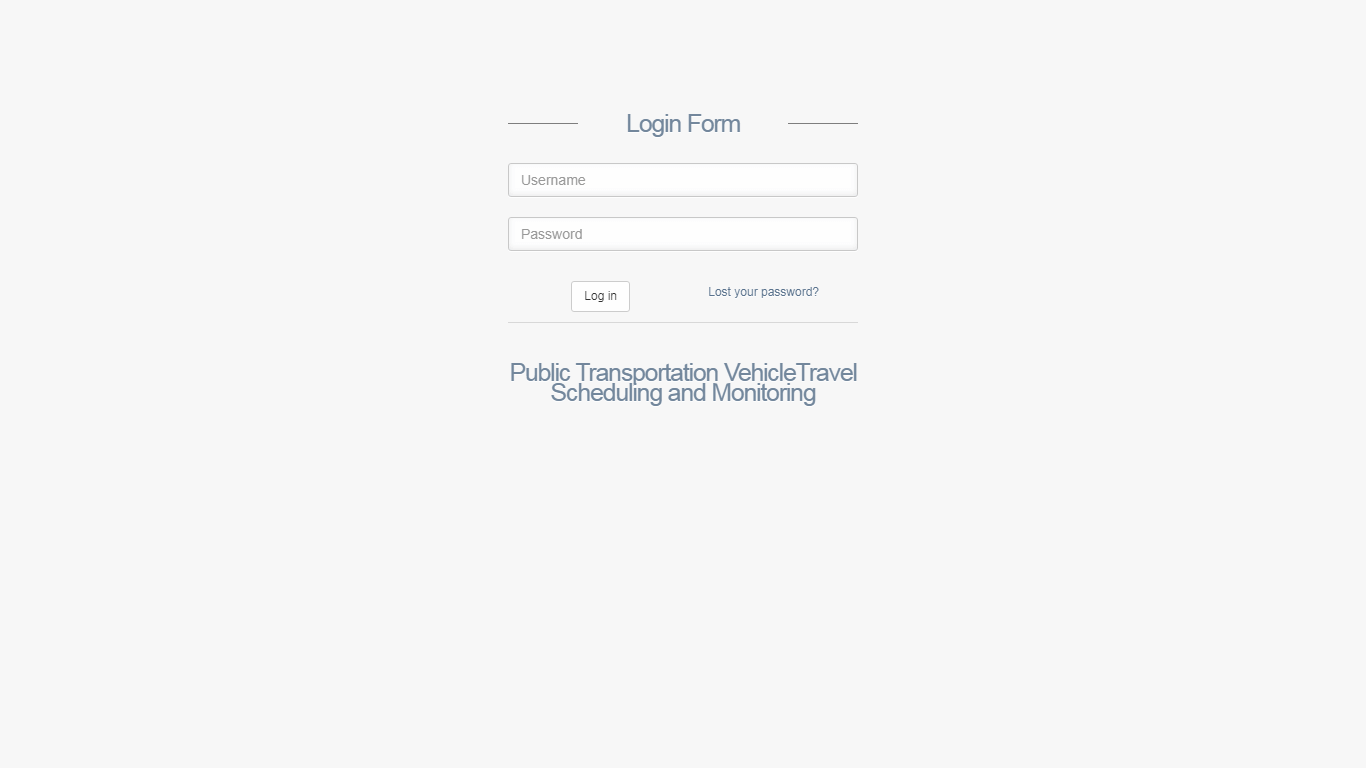Public Transportation Vehicle Travel Scheduling and Monitoring
The project entitled Public Transportation Vehicle Travel Scheduling and Monitoring is an online platform designed for public terminals to monitor the schedules of buses and other public transportation vehicles. PHP, MySQL and Bootstrap were used in the development of the project. With the use and implementation of this system, it will be very convenient on the side of the commuters for they can view the list of schedules using their mobile devices.

Related Literature
There are many ways to improve transit service quality, including reduced crowding, increased service frequency, nicer waiting areas, and better user information (Litman, 2008). Traditional transport evaluation methods tend to focus on cost-effective transit improvement strategies, resulting in under-investment in transit service quality improvements. Such circumstances in turn make transit less attractive compared to automobile travel. Service quality improvements that reduce the unit cost of travel time provide benefits that are comparable to speed improvement in reducing total travel time. Adaptive Control Model ANN Traffic Demand Forecasting Model ( Q1 and Q2 ) Analytical Signal Control Model Expected Timing Plan ( t1 and t2 ) Historical Data Performance Estimation (Total Delay) Proceedings of the Eastern Asia Society for Transportation Studies, Vol.9, 2013 Another way to improve transit service quality is providing transit users with real-time, reliable information at bus stops and terminals (e.g., signs, printed and posted schedules, conventional and automated telephone services, transit websites, changeable signs or monitors at stations and stops, and announcements). New technologies for predicting next vehicle arrival time at a particular destination have been articulated with real-time information provided to transit users. Conventional planning practices tend to solve problems and focus on service quality issues in single-level bus terminals. However, transit systems must handle greater traffic loads as populations in urban area continue to increase, particularly in central districts. Multi-level transportation terminals represent a solution to this problem, and have become a trend in high-density areas. Thus, improving multi-level terminal operational performance is a critical task in major cities around the world. Traffic control systems evolved through several generations. The first generation of such systems has been based on historical traffic data. The second generation took advantage of detectors, which enabled the collection of real-time traffic data, in order to re-adjust and select traffic signalization programs. The third generation provides the ability to forecast traffic conditions, in order to have traffic signalization programs and strategies pre-computed and applied at the most appropriate time frame for the optimal control of the current traffic conditions (Mitsakis, 2011). Significant delay occurs during peak periods at the Cheng-De exit of TBS. Taking into consideration TBS geographic constraints and operational characteristics; Wei et al. (2011) optimized signal timing to reduce the delay. The proposed model clearly indicates the relationships among flow rate, capacity, discharge time, and delay. The delay is sensitive to discharge time allocated for each direction, especially at peak periods with high traffic volumes. Results show that performance of the proposed model is promising. Reduction of delays by 22%-38% was observed at different times of the day. Adaptive signal control, the latest generation of dynamic signal control methods, refers to any signal control strategy that can adjust signal operations in response to fluctuating traffic demand and achieve greater efficiency than pre-timed systems in stops, delays, and emissions. Among the adaptive control strategies, the Sydney Coordinated Adaptive Traffic System (SCATS) and Split, Cycle and Offset Optimization Technique (SCOOT) models have been applied in several cities to achieve transportation system effectiveness and efficiency. However, these two models are designed mainly for unban street systems and configuration is too complex to deploy in TBS. Different techniques have been considered to enhance traffic control performance and to minimize traffic delay. Applications with fuzzy logic in controlling traffic signals have been used since the 1970s. The strength of fuzzy logic lies in its capability of simulating the decision-making process of a human, a process that is often difficult to define with traditional mathematical methods. Zaied and Othman (2011) proposed a system to change green light duration involving fuzzy factors and tested it using real data collected from signalized intersections. It provided good results compared to a pre-timed control strategy when considering heavy traffic volumes due to reducing the unused green time and accelerating the phase’s sequences. Keyarsalan and Montazer (2011) discovered that traffic light control domain using a fuzzy ontology made lower average delay time concerning weather and congestion conditions when applied to isolated intersections. Modeling knowledge of this domain helps traffic agents and application examples manage traffic efficiently regarding real-time conditions( http://easts.info/on-line/proceedings/vol9/PDF/P347.pdf).

Prior Art
ANBESA CITY BUS SERVICES ENTERPRISE(ACBSE)
Is the only public enterprise that provides transport services in and around the city ADDIS ABABA. The enterprises uses a fixed bus scheduling system to serve passenger in 110 routes, however, this type of bus assignment system created a problem in the company’s operation and financial performance. So they decided to develop an optimum bus assignment method using linear programming after thorough analysis of the existing bus scheduling system, the LP model is developed and used to determine the optimal number of buses for each route in four shift(www.mirlabs.org),ijcisim>15cisim_38 by Berhan.
SCHEDULING AND ROUTING OF CITY BUSES AT KUWAIT PUBLIC TRANSPORT COMPANY
These papers present a model and related analysis for scheduling and routing of public buses in the state of Kuwait. In their current bus scheduling system is analyzed in order to identify their related problems and potential areas for improvements and to investigate appropriate solution approaches. Their bus scheduling and routing faced problems and its been for more than 40 years. In order for them to solve their problem in scheduling and routing first they have to use a linear programmer model to obtain an initial solution solution for the routing problem, which could be used as a base for further improvement(M Savsar,JAlnaqi,MAtash-International Journal of Applied,2012-ijorlu.lia4.ac.ir).
Improving Bus Terminal Operations with Internal Adaptive Traffic Control
Most public transportation systems, either highway or rail, are prone to various operational problems, including congestion, delays, poor on-time performance, high costs, and deteriorating quality of travel experience. However, there are some cases in which system performance can be elevated with new infrastructure, technology, and/or service and management innovations. Many studies have focused on location planning of a transit facility adjacent to potential destinations for large numbers of transit passengers. Optimizing the performance of transfer centres such as bus terminals and major train stations is also a popular subject in this field. The transit industry is not exempt from the trend toward increased use of new technologies. Global-positioning-systems (GPS) and other location technologies (e.g. RFID Systems) can be coupled with wireless communication, enabling transit vehicles to be tracked in real-time. These technologies make it possible to control and coordinate transit vehicle movement en-route, enhancing the connectivity between bus lines at transfer terminals. The Taipei Bus Station (TBS), inaugurated in 2009, is the main terminal and hub for intercity bus service (http://easts.info/on-line/proceedings/vol9/PDF/P347.pdf).
Synthesis
The related literature and studies included in this study have bearing in the development of the operational framework. The related studies are very similar to the present study in the sense that it emphasized the significant role of the system in the implementation of scheduling and monitoring system in public terminals.
The related studies were every useful in the framing and formulation of the survey questionnaire and the interpretation and analysis of data and most of all, it helped in the development of the system. The following is the summary of the related studies, its system implemented, the desirable features and the present study:
You may visit our Facebook page for more information, inquiries, and comments. Please subscribe also to our YouTube Channel to receive free capstone projects resources and computer programming tutorials.
Hire our team to do the project.


